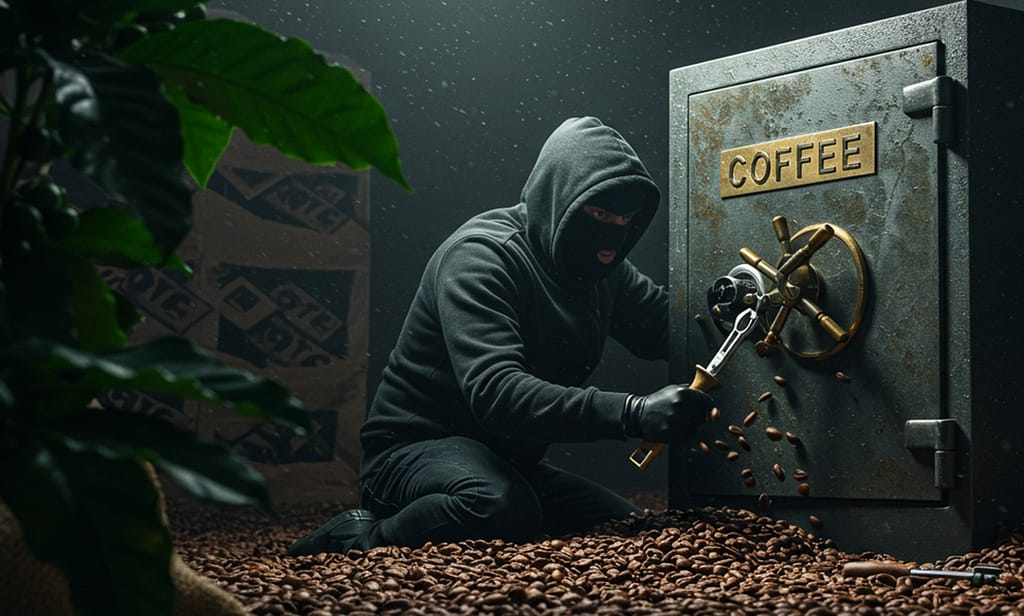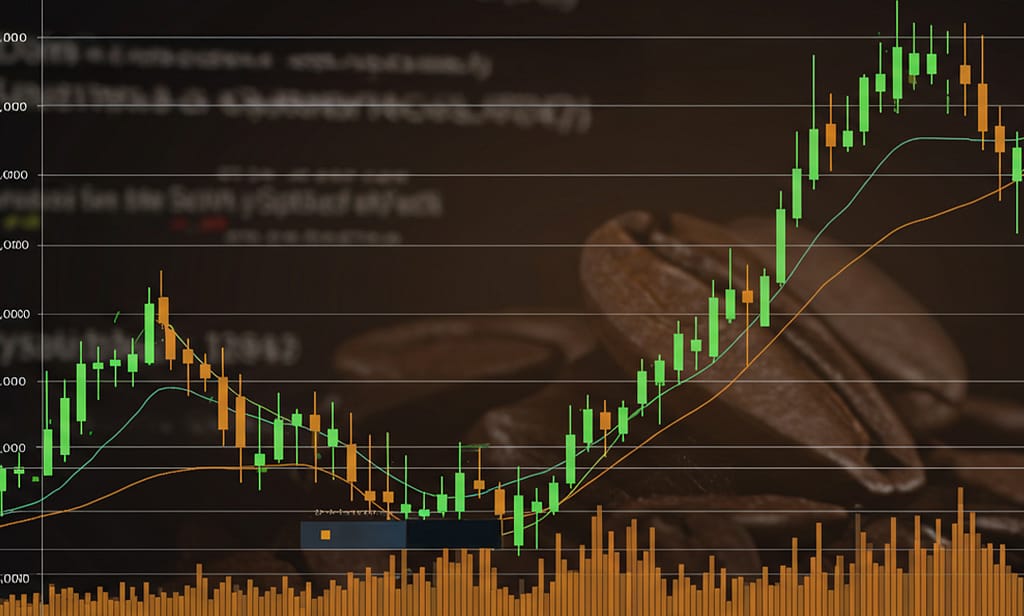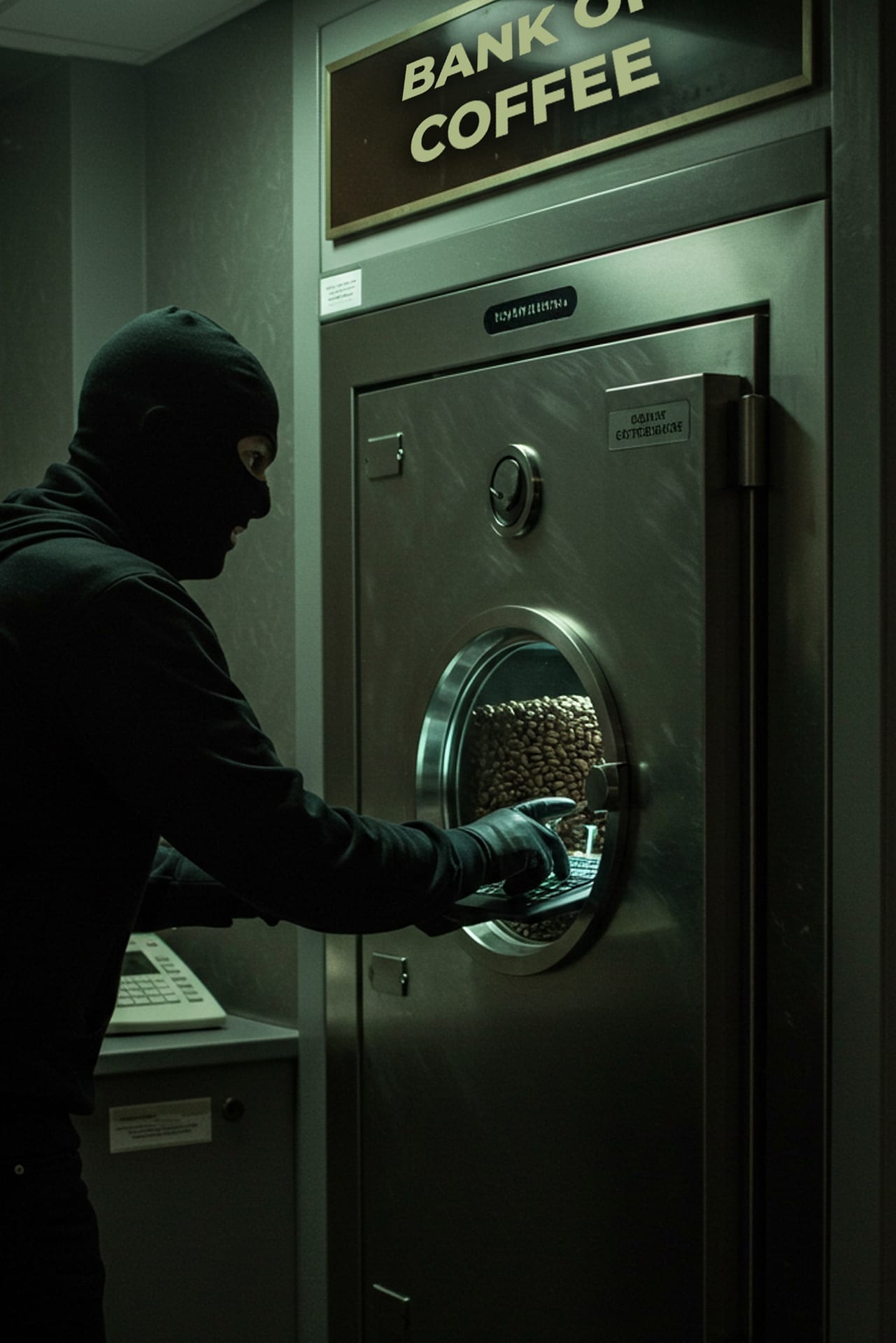Coffee theft is a big problem, not just a small issue. Imagine losing a shipment worth $135,000, but only getting $35,000 extra from insurance. This shows how big the problem is in the coffee industry crime world. With coffee prices at an all-time high, thieves are targeting shipments. They find weak spots in the logistics.

Even worse, solving claims can take up to nine months. This delay leaves businesses in a tough spot.
But there’s more to the story. A recent FAO report found that child labor and gender pay gaps cost $0.42 per kilogram in Ethiopia and Uganda. Deforestation and pollution also add to the costs, hitting small farmers the hardest. These problems affect everyone, from farmers to coffee drinkers.
Key Takeaways
- Insurance gaps leave $35,000 uncovered in high-value coffee theft cases
- Coffee theft delays disrupt supply chains, with claims taking up to nine months to resolve
- Double brokering, illegal in freight, enabled thefts by misrepresenting delivery locations
- Coffee prices hit historic peaks, pushing thieves to target shipments worth over $100,000
- Hidden costs like child labor and environmental damage add millions to coffee’s true cost
Introduction
The Growing Problem of Coffee Theft
In the U.S., dozens of green coffee thefts have been reported in the past year. Prices have hit $4 per pound, near record highs. Climate shifts and supply chain issues have made beans a prime target.
Brazil’s struggle shows the ripple effects. Despite rising demand, per capita consumption dropped 2.22%. Arabica futures jumped 70%, squeezing global stockpiles.
Why This Issue Matters to Coffee Lovers
Higher prices and shortages hit home. Lavazza’s stalled expansion in China shows the industry’s strain. They aimed for 1,000 stores but only have 112.
Juan Valdez’s $40M plan to open 140 Spanish stores by 2032 shows companies trying to adapt. For drinkers, this means pricier lattes and less choice. It shows that coffee crime isn’t just a business problem; it’s your next cup at risk.
Understanding Coffee Theft
Types of Coffee Theft
- Armed Robberies: In Brazil, gangs like the one that stole 500 bags ($230,000) in 2023 target farms with beans.
- Transport Heists: Trucks carrying 44,000 lbs of coffee (worth $180,000) get hijacked on highways, messing up supply chains.
- Local Theft: Small farmers lose beans from drying beds or storage areas, hurting their main income.
Who Commits These Crimes
From gangs to individuals, the culprits vary:
- Organized Crime Networks: They use violence and inside info for big operations.
- Opportunists: They steal small amounts from weak farms or warehouses.
- Fraudulent Transporters: They pretend to be real companies to grab shipments.
In the U.S., theft reports have gone up, with many recent cases. These crimes hit hard in places like Brazil, Uganda, and Kenya during harvest times. Farmers face not just money loss but also stress and worry that threaten their way of life.
Why Coffee Is a Target for Theft

High coffee prices and weak supply chains lead to coffee industry crime. The demand for coffee has gone up, and so have the prices of beans. This makes every pound a tempting target for thieves, from farms to shipping routes.
A record $220,000 coffee theft in Brazil’s Minas Gerais region highlights the lucrative nature of black market coffee.
The Economics Behind Coffee Theft
Thieves go after coffee because it’s very valuable compared to its weight. A truck can carry 44,000 lbs of beans worth $180,000. This makes stealing coffee very profitable. Organized gangs take advantage of weak security and remote farm locations, mainly during harvest times.
- High Value: Beans now fetch record prices due to climate-driven shortages.
- Easy Transport: Beans are lightweight and non-perishable, easy to move undetected.
- Seasonal Vulnerability: Once-a-year harvests create predictable theft opportunities.
Coffee's Rising Value as a Commodity
Global demand keeps pushing coffee prices up. The C price for coffee hit near-record highs, with arabica futures up 70% in recent years. This rise is due to climate disasters like Brazil’s droughts cutting yields.
U.S. consumers now drive this demand: 67% of adults drink coffee daily, up from 49% in 2004. Pandemic-driven supply chain chaos worsened delays, creating a perfect storm for black market coffee networks.
Recent Incidents of Coffee Theft
Coffee theft has become a big problem lately. Thieves are stealing coffee from ports and farms. In the U.S., groups pretending to be transport firms have stolen millions of dollars’ worth of coffee. Farms in Brazil and Uganda are also being raided by armed gangs at night.
High-Profile Coffee Heists
- In January 2024, thieves stole $230,000 worth of coffee beans from a Brazilian farm.
- In Kenya, gangs used drones to scout farms before stealing unprocessed beans.
- In 2023, a U.S. exporter lost $180,000 when a fake shipping company vanished with a truckload of green coffee.
Patterns and Trends in Theft Reports
Data shows a clear shift in how coffee crime operates:
Now, organized networks are behind most thefts. The International Coffee Organization reports prices hit record highs in February. This makes coffee theft very profitable. A freight broker recently said:
“Dozens of thefts in the last year show criminals are adapting faster than security measures.”
Exports dropped 14.2% in February. This shows how coffee theft disrupts trade. As prices go up, thieves target every stage, from farms to warehouses. This highlights the need for better security.
How Stolen Coffee Enters the Black Market
Black market coffee moves through secret networks, avoiding legal paths to reach buyers. It often begins with theft from farms or warehouses. Criminal groups then sell it to small roasters looking to save money. This hidden trade is big in places like Kenya, where farmers have lost up to 30% of their crops.
Smugglers move stolen coffee at night, sometimes using bribes to get past checkpoints. In El Salvador, gangs steal beans from remote farms before they’re processed. These beans are sold to buyers who don’t care where they come from.
- Thieves mix stolen beans with real ones to avoid being caught.
- Prices can drop to $0.10 per kilo, much lower than fair prices.
- Corrupt officials help by making fake shipping documents.
Finding stolen coffee is hard. Roasters might buy it without knowing, because of unclear sources. Farmers in Kenya’s Nyeri region face thefts often, but there’s no punishment for thieves. Even when stolen coffee is found, it’s sometimes labeled as something else, like maize, to hide the extent of the theft.
At a meeting in Houston, experts talked about how black market coffee hurts small farmers. When thieves sell beans for $0.10/kg, it lowers prices for honest farmers. This forces struggling businesses to buy cheaper, stolen coffee.
Economic Impact of Coffee Theft
Coffee theft hurts small farmers in many ways. It’s a hidden crisis that affects farmers and consumers worldwide. From Uganda to Brazil, the damage is felt by everyone involved.
Effects on Farmers and Producers
Imagine a Colombian farmer losing 10 bags of coffee to thieves. This loss can cut their yearly income by thousands. Here’s what’s happening:
- Security costs now take 18% of farm budgets, up from 5% in 2020
- Half of affected farmers can’t sleep well because of theft stress
- Some areas see harvest losses of 30% every year
Ripple Effects Through the Supply Chain
When farmers lose, the whole supply chain feels it. Here’s how the damage spreads:
- Retail prices go up 12% in areas with high theft rates
- Rosasters add “theft premiums” to bean prices
- Investors avoid areas hit by coffee industry crime
This situation makes consumers pay more and farmers earn less. The coffee theft crisis is not just a crime. It’s a financial threat to the coffee industry’s future.
How the Industry Is Fighting Back
The coffee industry is coming together to fight coffee crime and protect jobs. Farmers in Kenya have found creative ways to keep thieves away. They’ve set up beehives and formed community patrols.
Importers are using GPS tracking and tamper-proof packaging. These steps are now common to keep coffee safe.
Security Innovations in Action
- Ugandan farmers use guard dogs and motion-sensor lights to secure plantations.
- Meru Central Farmers Co-operative reduced losses by 50% through shared surveillance systems.
- Othaya Co-op invested in direct export tech, cutting out middlemen who enable coffee industry crime.
Collaboration and Technology
At the National Coffee Association summit in Houston, leaders agreed: sharing data is key. Roasters now use blockchain to track beans from farm to store. Law enforcement in Colombia and Brazil are now focusing on coffee theft.
“Tracking every step from cherry to cup stops criminals mid-stride,” said a panelist at the summit.
Smallholder farmers in Kenya’s central region are joining cooperatives for security. These groups also push for harsher penalties for theft. They aim to stop the 30,000+ kilos stolen each year.
Technology isn’t the only answer: training programs teach farmers to spot smuggling networks. Certifications like Rainforest Alliance now include anti-theft clauses in audits. Every effort is aimed at fighting coffee crime.
What Consumers Can Do to Help
Every coffee lover can help stop coffee theft. By choosing wisely, we support fair trade and hurt the black market coffee business. Look for brands that are open about where they get their beans. Fair Trade and Rainforest Alliance certifications mean farmers are paid right.
Smaller roasters often work directly with farmers. This cuts down on risks in the supply chain.
- Choose brands like Westrock Coffee Company, investing in ethical sourcing and sustainability.
- Avoid stores offering beans at prices too good to be true—these may fund illegal operations.
- Follow Odeko’s lead by using apps that track supply chain origins to verify legitimacy.
Making Ethical Coffee Choices
Ask about where the coffee comes from. Stores like Whole Foods Market or local micro-roasters share stories. The International Coffee Organization’s 2024 report shows higher prices mean honest producers need our support now more than ever.
Supporting Anti-Theft Initiatives
Spread the word on social media or in your community. Share how coffee theft hurts farmers. Join groups like Fair Trade USA’s advocacy programs.
Retailers using AI, like Home Depot’s computer vision models, show tech can help. But, it’s our demand that really drives change.
Together, we can make a difference. Every time we buy coffee, we vote for a fairer world. Let’s make it happen, one cup at a time.
Conclusion: The Future of Coffee Security
The battle against coffee crime and coffee industry crime needs quick action. Climate change and higher prices are changing the game. They pose new dangers for farmers and businesses.
Emerging Threats and Challenges
Climate changes might reduce land for arabica coffee by half by 2050. This will make getting resources harder. Small farms in places like Sumatra, linked to deforestation, show how harm to the environment and coffee industry crime go hand in hand.
Big companies like Starbucks and J.M. Smucker must tackle these problems. They need to help avoid more harm to already struggling communities.
Building a More Secure Coffee Industry
Technology like blockchain and stricter laws, like the EU’s EUDR, offer hope. But, companies like Kraft Heinz need to step up. They ignored recent surveys on sustainability.
The 2023 Coffee Barometer says fair prices for farmers are key. Without them, coffee crime will only grow. Consumers can make a difference by picking brands that are open and fair in their sourcing.
We must turn knowing the problem into doing something about it. Supporting certifications and making companies answer for their actions is crucial. This way, coffee can stay a shared joy, not a target for theft or unfair treatment. Our choices today will help make a better future for this beloved drink.
FAQ
What is coffee theft and how does it impact the coffee industry?
Coffee theft is when people steal coffee beans at different stages. It hurts farmers, distributors, and those who buy coffee. As theft grows, prices go up, farmers lose money, and honest businesses struggle.
Why has coffee become such a valuable target for thieves?
Coffee is in high demand and prices are rising. It’s also light but valuable, making it attractive to thieves. This creates a perfect setup for organized crime to make money from coffee theft.
What types of coffee theft are most common?
There are many types of coffee theft. It includes armed robberies at farms, theft during transport, and theft from storage. These range from simple thefts to complex operations by criminal groups.
How do thieves typically operate?
Thieves can be solo opportunists or part of big organized groups. Some groups pretend to be real transport companies to get coffee contracts. Then, they take the coffee.
What happens to stolen coffee once it’s taken?
Stolen coffee goes into a secret supply chain. It’s mixed with real coffee to sell it again. This way, it’s hard to tell if the coffee is stolen or not.
How does coffee theft affect farmers and producers?
Coffee theft hurts farmers a lot, even if it’s just a little. It can cut their income a lot. Farmers also have to spend more on security, which raises their costs.
What innovative measures are being taken to address coffee theft?
The industry is using new ways to keep coffee safe. This includes tracking devices and using beehives to scare off thieves. They’re also working together with law enforcement and coffee companies to fight theft.
What can consumers do to help prevent coffee theft?
Consumers can help by choosing coffee from fair trade and transparent sources. By talking about the problem and choosing not to buy cheap coffee, they can help stop theft.
What is the future of coffee security as it relates to theft?
As climate change affects coffee, theft might get worse. But, new security tech and teamwork in the coffee world could help fight it.










